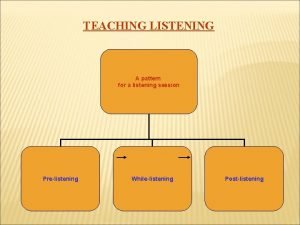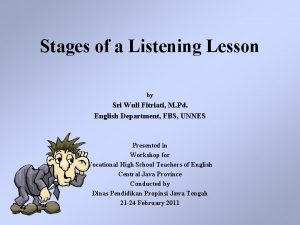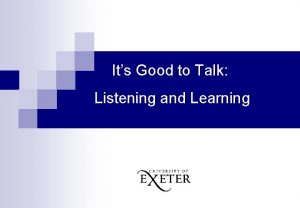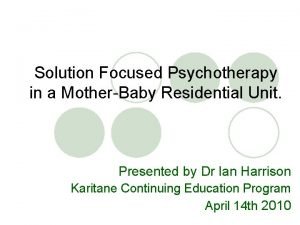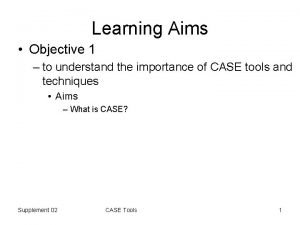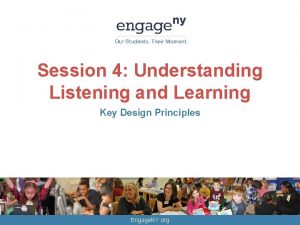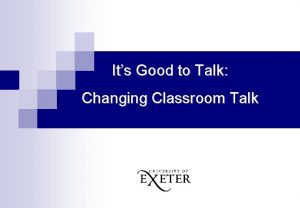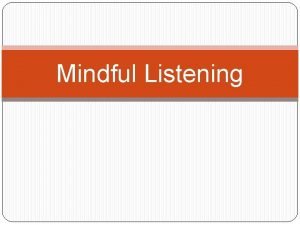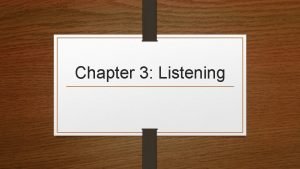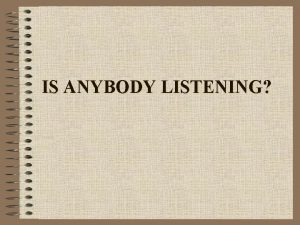Its Good to Talk Listening and Learning Aims

















- Slides: 17

It’s Good to Talk: Listening and Learning

Aims of the Session: Exploring how teachers can develop children’s listening skills: n Using games to promote listening; n Teaching active listening n Supporting listening in group talk.

Network Day Task n Discuss the transcript/s from your lessons, looking particularly at: ¨ Different categories of questions ¨ Examples of misunderstanding ¨ Extracts of talk going well ¨ Different questioning styles ¨ How well you listen to children’s responses

Listening We all do a lot of listening! n Of all the time we spend communicating… n 45% is listening n 30% is speaking n 16% reading n 9% writing. You can’t speak a language until you have listened to it!

Listening Classrooms? n ‘Children should be seen and not heard’; n ‘Stop talking’ n ‘Please listen’ n ‘Are you listening? ’ Listening is very often linked with behaviour, obedience and compliance, not with an active sense of developing spoken interaction and learning through talk.

Active Listening Ø Active listening is listening for learning, Ø Passive listening is linked to behaviour and is more about the absence of talk , than being a good listener. Ø Active listening is responsive: it is part of building and sustaining talk for learning. Ø Passive listening is unreactive: it does not contribute to the development of discussion or thinking. Listening is more active than hearing: we all hear lots of things we don’t recall

Why don’t children listen? n Poor concentration and attention span n Limited experiences of being listened to n Limited structured opportunities to develop listening skills n Focused on self (and talk) rather than others n Dislike of sitting still – desire to fidget n Poor social interaction skills Listening is a skill which needs to be explicitly taught, and listening opportunities explicitly planned into teaching.

Listening Foundations We should work on: n Becoming aware of sounds: what sounds do we hear in different places and different situations (eg the playground; a hospital) n Recognising and identifying sounds: being able to match sounds to sources n Discriminating between sounds: being able to distinguish between similar sounds (eg different engine noises: car/plane) and being able to group together similar sounds (eg things that buzz)

Listening Games http: //www. btbetterworld. com/pg/developing_skills/free_resources/Communic ation_Cookbook_-_Listening_Walk/home. ikml Try Bailey Bear’s Listening Walk http: //www. lancsngfl. ac. uk/curriculum/literacyresources/index. php? category_i d=22&s=!B 121 cf 29 d 70 ec 8 a 3 d 54 a 33343010 cc 2 n Look at Listening Games

What makes a good listener? n Paying attention n Showing you are listening, with your body as well as your ears n Providing feedback (smiles, nods, mm) n Asking questions to check understanding n Giving the speaker time to speak (ie no interrupting) n Replying to what they have said rather than what you want to say.

Storytelling to support listening Storytelling: n encourages sustained active listening n develops concentration and attentiveness n invites listeners to convert words into images n develops awareness of oral patterns such as rhyme, rhythm and repetition n models the articulate use of oral language.

Storytelling n “Teachers are often surprised at the length of time that very young pupils and teenagers can be held in a state of attentive listening by a good storyteller. That state is sometimes called 'being spellbound‘. ” http: //www. thestoryspinner. co. uk/index. htm

Listening and Responding Using the Learning Objectives for Listening and Responding: n choose a year group n think of teaching activities which would help to explicitly develop those listening skills. n write these down clearly so that we can collate them for the website.

Next Network Session Pre-session task: n Create your own activities to develop listening skills, or try some of the ones on the website n Evaluate how well they work and adapt them if necessary. n Bring a clear outline and explanation of the two most successful activities to the next Network Session

http: //education. exeter. ac. uk/pages. php? id=543

n The greatest compliment that was ever paid me was when someone asked me what I thought, and then attended to my answer. - Henry David Thoreau

P 4 C: Year 2 -3 children Teacher: Why did the mother think that her baby was best? Child: Because it was beautiful. She thought it was beautiful. Child: She thought it was beautiful because she was the mother. Teacher: What does it mean to be beautiful? Child: It means someone thinks you are lovely. Child: You are perfect. . . Child: Good to look at. Teacher: Can you be beautiful even if no-one thinks you are lovely? Child: No. You can’t be beautiful if no-one thinks you are beautiful. Child: You can be beautiful inside, you can feel beautiful. . .
 Pre listening activities
Pre listening activities Stages of a listening lesson
Stages of a listening lesson Listening aims
Listening aims Talk, read talk write template
Talk, read talk write template Amateurs discuss tactics professionals discuss logistics
Amateurs discuss tactics professionals discuss logistics The words use are not
The words use are not Zoroastrianism good thoughts good deeds
Zoroastrianism good thoughts good deeds Hi good morning video
Hi good morning video Good evening students
Good evening students You are good when theres nothing good in me
You are good when theres nothing good in me Good afternoon buenas tardes
Good afternoon buenas tardes Active vs passive listener
Active vs passive listener What is the purpose of critical listening?
What is the purpose of critical listening? Specific aims research proposal example
Specific aims research proposal example Cuadro comparativo e-learning m-learning b-learning
Cuadro comparativo e-learning m-learning b-learning Learning aims database
Learning aims database Ckla listening and learning
Ckla listening and learning Emigree poem annotated
Emigree poem annotated
